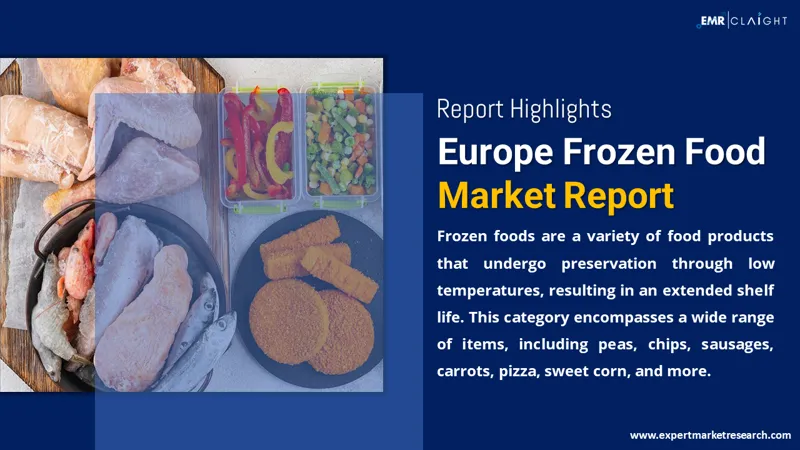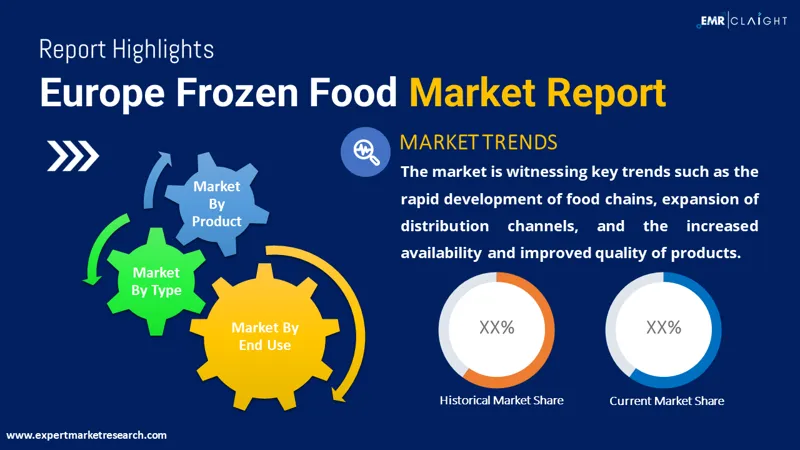
Consumer Insights
Uncover trends and behaviors shaping consumer choices today
Procurement Insights
Optimize your sourcing strategy with key market data
Industry Stats
Stay ahead with the latest trends and market analysis.
Trending Now



The Europe frozen food market was valued to reach a market size of USD 65.24 Billion in 2024. The industry is expected to grow at a CAGR of 2.80% during the forecast period of 2025-2034. The growing consumer demand for convenience, healthier frozen meals, and plant-based options, alongside sustainable practices, is driving the Europe frozen food market, thus aiding the market growth to attain a valuation of USD 85.99 Billion by 2034.
Base Year
Historical Year
Forecast Year
In Europe, increasing preference of easy-to-eat and ready-to-cook foods is further encouraging demand for frozen food, thereby compelling B2B businesses to increase production, logistics, and effectiveness of cold chains.
Improved freezing technology like IQF (Individually Quick Frozen) and cryogenic freezing results in higher quality products with better shelf life, which opens up new avenues for B2B suppliers in food processing and packaging industries. This aids in boosting the growth of the Europe frozen food market.
Growing focus on reducing food waste and using sustainable packaging materials encourages B2B collaborations for eco-friendly frozen food solutions, thereby enhancing market opportunities across Europe and globally.






Value in USD Billion
2025-2034
Europe Frozen Food Market Outlook
*this image is indicative*
| Europe Frozen Food Market Report Summary | Description | Value |
| Base Year | USD Billion | 2024 |
| Historical Period | USD Billion | 2018-2024 |
| Forecast Period | USD Billion | 2025-2034 |
| Market Size 2024 | USD Billion | 65.24 |
| Market Size 2034 | USD Billion | 85.99 |
| CAGR 2018-2024 | Percentage | XX% |
| CAGR 2025-2034 | Percentage | 2.80% |
| CAGR 2025-2034 - Market by Region | United Kingdom | 3.0% |
| CAGR 2025-2034 - Market by Region | Italy | 2.6% |
| CAGR 2025-2034 - Market by Type | Ready-to-Eat | 3.1% |
| CAGR 2025-2034 - Market by End Use | Retail | 2.5% |
| 2024 Market Share by Region | Germany | 23.6% |
The Europe frozen food market is growing rapidly and gaining importance on premium quality, convenience, and sustainability. The interest of the consumers in healthier and more diversified frozen options is on the rise, thereby creating an opportunity for organic, gluten-free, and low-calorie products in the market. Retailers are increasing their frozen food sections to meet the demand for quick, nutritious meals, thus driving the Europe frozen food market growth.
Market is also witnessing an increased level of competition from brands and private labels through innovation in products and packaging. Technological advancements in the freezing process maintain the quality of the food while retaining nutritional value. Since the region emphasizes waste reduction and sustainability, the companies are moving towards energy-efficient manufacturing and environment-friendly packaging. E-commerce is growing, offering customers more convenient options to buy frozen food, which adds to the market growth in Europe.

Read more about this report - REQUEST FREE SAMPLE COPY IN PDF
Growth in the frozen food market in Europe is due to the increased demand for easy and time-saving meals, particularly from busy households and working professionals. Also, a rising preference for healthier frozen food options, including low-calorie, organic, and plant-based products, contributes to Europe frozen food demand growth. Innovation in freezing technology and packaging that preserves the quality of food and extends shelf life also drives the growth of the market. With an increase in demand for online grocery shopping and green products, the area is witnessing high ongoing demand.
Europe frozen food market is driven by plant-based demand, private-label expansion, advanced freezing technology, and sustainable packaging, creating B2B opportunities in innovation, supply chain optimization, and eco-friendly solutions.
The rising trend of adopting plant-based diets is driving the demand for frozen vegan and vegetarian meals in Europe. Consumers demand meat alternatives, plant-based ready meals, and frozen fruits and vegetables, which push food manufacturers and B2B suppliers to produce innovative, sustainable, and high-quality plant-based frozen products to accommodate changing dietary trends.
With an increasing number of supermarkets and retailers investing in private-label frozen food lines, offering cost-effective and high-quality products compared to their branded counterparts, this trend continues to fuel competition and open the door for B2B manufacturers to work closely with retailers on exclusive frozen meals, snacks, and ingredients tailored to the local European market demand.
Technological innovations include Individual Quick Freezing (IQF) and high-pressure processing (HPP), which improve frozen food quality for freshness, texture, and nutrition. European B2B firms are using the above technologies to create premium frozen foods with longer shelf life and improve efficiency in food supply chains.
The increasing environmental concerns and stringent European regulations are compelling frozen food companies to opt for sustainable packaging materials and optimize supply chains. B2B firms are investing in biodegradable packaging, energy-efficient cold storage, and carbon-neutral logistics to meet sustainability goals and consumer expectations for eco-friendly frozen food products.
Plant-based and health-conscious product lines are significant opportunities in the frozen food market of Europe. Growing vegan, gluten-free, and low-carb demand creates a perfect environment for innovations in eco-friendly packaging and sustainable sourcing. It allows brands to get aligned with the sustainability demands of consumers. In addition, growing ready-to-eat meal kits and frozen meal kits demand provides B2B opportunities to the suppliers. Rising online grocery shopping may also allow the e-commerce platforms to grow in terms of the variety of frozen food products for the convenience-seeking customers.
Some niche trends in the European frozen food market are a growth in frozen ethnic cuisine, as consumers become increasingly interested in international flavors, shaping new trends in the Europe frozen food market. There is also a growing interest in functional frozen foods that contain added nutrients such as proteins or probiotics. The premium frozen product category, which includes gourmet frozen meals and organic frozen products, continues to increase. Moreover, the adoption of biodegradable and recyclable packaging materials for frozen food production will meet the sustainability criteria along the region.
The limited shelf life of some frozen items is a significant restraint to the Europe frozen food industry since it can hinder logistics and lead to potential waste. In addition, variations in regional food preferences and regulatory standards pose Europe frozen food market challenges toward standardization and scalability of the market. Moreover, the high energy costs related to cold storage and transportation continue to limit the profitability of small producers, whereas the increasing competition due to low-priced imports affects both pricing and market position.

Read more about this report - REQUEST FREE SAMPLE COPY IN PDF
“Europe Frozen Food Market Report and Forecast 2025-2034” offers a detailed analysis of the market based on the following segments:
Market Breakup by Product:
Market Breakup by Type:
Market Breakup by Distribution Channel:
Market Breakup by End Use:
Market Breakup by Region:
Market Analysis by Product
Frozen prepared meals are increasingly used owing to the increased demand among busy consumers for convenient and time-saving products. This boosts frozen fish and seafood usage because of consumer demands for healthier, higher protein options. As per Europe frozen food market analysis, frozen meat and poultry benefit from the growing trend toward high-quality, sustainable sources. Frozen fruits and vegetables are popular because consumers perceive them as nutritious yet easy to consume. Frozen baked goods are on the rise because consumers are demanding fresh-tasting, easy-to-consume options. Frozen pizza remains a favorite due to its convenience and variety.
Market Insights by Type
Raw material frozen foods are getting popular in the Europe frozen food market because consumers prefer to use high-quality ingredients for home cooking. Half-cooked options are becoming popular because of their convenience: consumers can quickly complete meals without sacrificing quality. Ready-to-eat frozen meals are thriving because of their ease of preparation, especially for busy lifestyles. As the demand for healthier and sustainable options increases, frozen foods are adjusting to meet consumer demands for nutrition and convenience.
Distribution Channel Analysis
Online channels are the fastest growing segment in the European frozen food market by distribution channel, primarily because of the convenience of home delivery, especially for busy consumers and those seeking specialty products. As per Europe frozen food industry analysis, e-commerce platforms offer a wide variety of frozen foods, including niche and organic options. Offline channels, such as supermarkets and hypermarkets, remain strong and offer in-store experiences and immediate access to frozen foods, with an emphasis on larger selections and promotions.
Market Analysis by End Use
The market for frozen foods is growing in Europe due to convenience, healthier, and home-cooked meal preparation. Retail has gained momentum. In supermarkets and on the internet, frozen food sections are being enlarged to cater to consumers' needs. Food service also grows as restaurants, caterers, and fast-food chains look for lower-cost, better quality frozen ingredients that will help run their operations smoothly. Ready-to-cook and ready-to-eat demand is increasing.
Russia Frozen Food Market Dynamics
Demand for frozen foods in Russia has been driven mainly by the fact that the busy life of consumers there leads to greater consumption of easy, ready-to-eat foods. Furthermore, the rapid expansion of modern retail channels and supermarkets in urban locations has increased frozen food availability and thereby fueled market growth. There's also a new trend toward more healthy frozen food choices, like vegetables and fruits, as a healthier diet.
France Frozen Food Market Trends
Demand in frozen food in France is driven by consumer preference for premium-quality, premium-priced frozen meals. Gourmet versions specifically are in high demand. Convenience is increasingly important for busy consumers, who seek ready-to-eat, easy-to-prepare frozen products. Sustainability is also on the rise in France, where packaging that is eco-friendly and organic frozen foods are sought by consumers for sustainable consumption.
Netherlands Frozen Food Market Drivers
In terms of convenience and health, frozen food demand in the Netherlands is booming, as consumers prefer quicker yet nutritious meal solutions. Rising demand for plant-based diets also increases the demand for frozen vegetables and meat alternatives. E-commerce and online grocery shopping play a leading role in growth, where greater variety of frozen meals to ingredients is easy access for consumers to buy online.
| CAGR 2025-2034 - Market by | Region |
| United Kingdom | 3.0% |
| Italy | 2.6% |
| Germany | XX% |
| France | XX% |
| Others | XX% |
Poland Frozen Food Market Opportunities
Ready-to-eat and ready-to-cook food items are growing as a convenience meal option for time-crunched families in Poland. Disposable incomes also contribute to increasing willingness to spend money on better frozen product quality in the form of higher-quality meat, seafood, and vegetables. Growing healthy-eating habits drive interest in organic and natural frozen food choices.
Germany Frozen Food Market Outlook
German frozen food demand is heavily influenced by the growing trend for convenience, which sees busy individuals favor ready-to-eat or quick preparation meals. Additionally, Germans increasingly prefer sustainable, quality frozen products such as organic vegetables and fruits, plant-based meals. The online grocery shopping market continues to grow and add to the increase in the use and demand for frozen food as a more convenient method for German consumers.
Europe frozen food market players focus on innovation, sustainability, and convenience. They expand product lines from the plant-based type, freezing technology to have superior quality, and eco-friendly type of packaging. Europe frozen food companies would try to deepen partnerships with private label retailers and perfecting cold chain logistics to meet demand with high quality nutrition and sustainable quality frozen foods among consumers.
FRoSTA AG, founded in 1905, is based in Bremerhaven, Germany, and is offering frozen meals, vegetables, and fish products in various forms. It emphasizes using natural ingredients, as well as sustainability, targeting the healthy conscious consumers across Europe with clean-label frozen foods.
McCain Foods Limited is a company founded in 1957 and headquartered in Toronto, Canada. It is famous for its frozen potato products, including French fries, and also offers a variety of frozen snacks, meals, and appetizers. The company focuses on sustainability and quality in its offerings, serving Europe and global markets.
Established in 1992, Fevita Hungary Zrt is located in Székesfehérvár, Hungary, and is specialized in frozen fruits, vegetables, and ready-to-cook meals. The company offers a high-quality, convenient frozen food solution for both retail and foodservice sectors for the European consumer.
Handsman Sp. z o.o. has been established since 1991 in Lublin, Poland. Its frozen vegetables, fruits, and ready-made meals are marketed to the retail and foodservice sectors, where it aims for optimal quality at European market prices.
*Please note that this is only a partial list; the complete list of key players is available in the full report. Additionally, the list of key players can be customized to better suit your needs.*
Other players in the Europe frozen food market include FRUWE s.r.o, Friall, s.r.o., Good Food Group A/S, and Dawtona Frozen, Minit Slovakia, among others.
Europe Frozen Food Market Size
*While we strive to always give you current and accurate information, the numbers depicted on the website are indicative and may differ from the actual numbers in the main report. At Expert Market Research, we aim to bring you the latest insights and trends in the market. Using our analyses and forecasts, stakeholders can understand the market dynamics, navigate challenges, and capitalize on opportunities to make data-driven strategic decisions.*
Get in touch with us for a customized solution tailored to your unique requirements and save upto 35%!
In 2024, the market reached an approximate value of USD 65.24 Billion.
The Europe frozen food market is assessed to grow at a CAGR of 2.80% between 2025 and 2034.
The market is estimated to witness healthy growth in the forecast period of 2025-2034 to reach a value of around USD 85.99 Billion by 2034.
The increasing popularity of frozen food, the globalisation of cuisines, and the introduction of healthy frozen meals are the major market drivers.
The key trends guiding the market include the expanding distribution channels, the ease of availability of frozen food, and the increasing numbers of fast-food chains in the region.
The major regions in the Europe frozen food market are Russia, France, Netherlands, Poland, and Germany.
The significant end uses of frozen food are retail and food service.
The major players in the market are FRoSTA AG, McCain Foods Limited, Fevita Hungary Zrt, Handsman Sp. z o.o., FRUWE s.r.o, Friall, s.r.o., Good Food Group A/S, and Dawtona Frozen, Minit Slovakia, among others.
Explore our key highlights of the report and gain a concise overview of key findings, trends, and actionable insights that will empower your strategic decisions.
| REPORT FEATURES | DETAILS |
| Base Year | 2024 |
| Historical Period | 2018-2024 |
| Forecast Period | 2025-2034 |
| Scope of the Report |
Historical and Forecast Trends, Industry Drivers and Constraints, Historical and Forecast Market Analysis by Segment:
|
| Breakup by Product |
|
| Breakup by Type |
|
| Breakup by Distribution channel |
|
| Breakup by End Use |
|
| Breakup by Region |
|
| Market Dynamics |
|
| Competitive Landscape |
|
| Companies Covered |
|
| Report Price and Purchase Option | Explore our purchase options that are best suited to your resources and industry needs. |
| Delivery Format | Delivered as an attached PDF and Excel through email, with an option of receiving an editable PPT, according to the purchase option. |
Datasheet
One User
USD 3,499
USD 3,149
tax inclusive*
Single User License
One User
USD 5,499
USD 4,949
tax inclusive*
Five User License
Five User
USD 6,999
USD 5,949
tax inclusive*
Corporate License
Unlimited Users
USD 8,324
USD 7,075
tax inclusive*
*Please note that the prices mentioned below are starting prices for each bundle type. Kindly contact our team for further details.*
Flash Bundle
Small Business Bundle
Growth Bundle
Enterprise Bundle
*Please note that the prices mentioned below are starting prices for each bundle type. Kindly contact our team for further details.*
Flash Bundle
Number of Reports: 3
20%
tax inclusive*
Small Business Bundle
Number of Reports: 5
25%
tax inclusive*
Growth Bundle
Number of Reports: 8
30%
tax inclusive*
Enterprise Bundle
Number of Reports: 10
35%
tax inclusive*
How To Order
Our step-by-step guide will help you select, purchase, and access your reports swiftly, ensuring you get the information that drives your decisions, right when you need it.

Select License Type
Choose the right license for your needs and access rights.

Click on ‘Buy Now’
Add the report to your cart with one click and proceed to register.

Select Mode of Payment
Choose a payment option for a secure checkout. You will be redirected accordingly.
Gain insights to stay ahead and seize opportunities.

Get insights & trends for a competitive edge.

Track prices with detailed trend reports.

Analyse trade data for supply chain insights.

Leverage cost reports for smart savings

Enhance supply chain with partnerships.

Connect For More Information
Our expert team of analysts will offer full support and resolve any queries regarding the report, before and after the purchase.
Our expert team of analysts will offer full support and resolve any queries regarding the report, before and after the purchase.
We employ meticulous research methods, blending advanced analytics and expert insights to deliver accurate, actionable industry intelligence, staying ahead of competitors.
Our skilled analysts offer unparalleled competitive advantage with detailed insights on current and emerging markets, ensuring your strategic edge.
We offer an in-depth yet simplified presentation of industry insights and analysis to meet your specific requirements effectively.



Australia
63 Fiona Drive, Tamworth, NSW
+61-448-061-727
India
C130 Sector 2 Noida, Uttar Pradesh 201301
+91-723-689-1189
Philippines
40th Floor, PBCom Tower, 6795 Ayala Avenue Cor V.A Rufino St. Makati City,1226.
+63-287-899-028, +63-967-048-3306
United Kingdom
6 Gardner Place, Becketts Close, Feltham TW14 0BX, Greater London
+44-753-713-2163
United States
30 North Gould Street, Sheridan, WY 82801
+1-415-325-5166
Vietnam
193/26/4 St.no.6, Ward Binh Hung Hoa, Binh Tan District, Ho Chi Minh City
+84-865-399-124
United States (Head Office)
30 North Gould Street, Sheridan, WY 82801
+1-415-325-5166
Australia
63 Fiona Drive, Tamworth, NSW
+61-448-061-727
India
C130 Sector 2 Noida, Uttar Pradesh 201301
+91-723-689-1189
Philippines
40th Floor, PBCom Tower, 6795 Ayala Avenue Cor V.A Rufino St. Makati City, 1226.
+63-287-899-028, +63-967-048-3306
United Kingdom
6 Gardner Place, Becketts Close, Feltham TW14 0BX, Greater London
+44-753-713-2163
Vietnam
193/26/4 St.no.6, Ward Binh Hung Hoa, Binh Tan District, Ho Chi Minh City
+84-865-399-124
Share